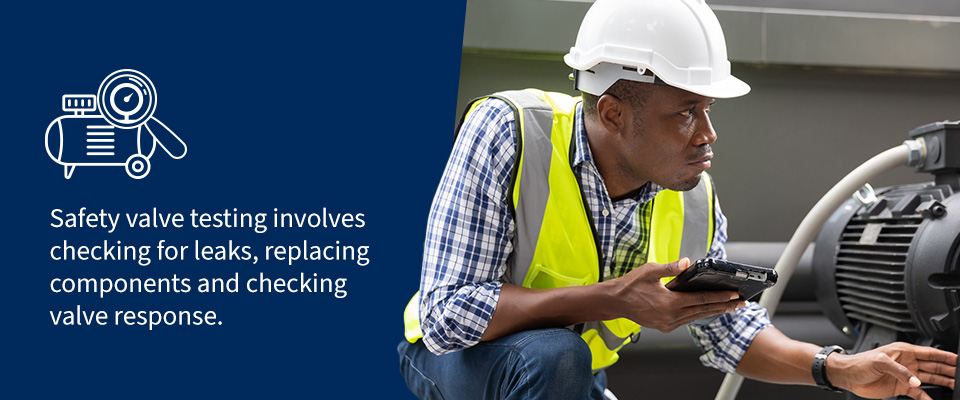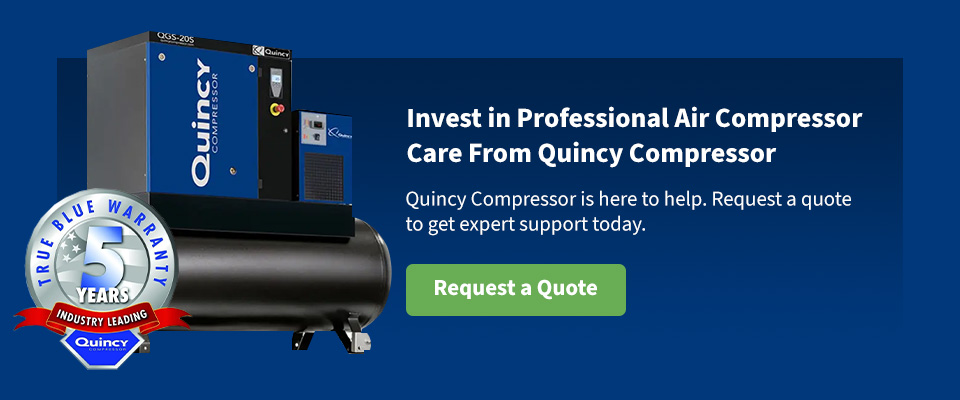Air compressors are essential for powering tools and machinery. Whether you’re in manufacturing or automotive repair, you depend on an air compressor to complete different tasks. Understanding how to maintain an air compressor ensures you keep efficiency up and save on repair costs while protecting your business.
While facilities can perform regular maintenance tasks on their own, certain annual maintenance tasks should be done by a professional. Neglecting these tasks can reduce efficiency, compromise productivity and lead to downtime.
Why Air Compressor Maintenance Matters
Air compressor preventive maintenance keeps your equipment in peak condition. When minor issues go unchecked, they can turn into major problems, such as downtime or equipment replacements. Businesses must invest in routine and annual maintenance to maximize system life span and protect operations. With so many ways to use air compressors, it’s critical that every industry knows how to care for them.
Air compressors operate under high pressure. These conditions lead to constant wear on components, which degrade over time and work less efficiently. A poorly maintained system will eventually struggle to produce the required air output. This creates a cycle where the system works harder to produce the same results, consuming more power and increasing wear. Eventually, you might see complete system failure.
Professional annual maintenance is necessary to prevent these problems. Experts will find wear and flaws and correct them to restore your system. Investing in annual air compressor maintenance reduces your overall expenses while protecting your air compressor.
Annual Air Compressor Maintenance Checklist
Industrial air compressor preventive maintenance should happen weekly, monthly and annually. Keep track of these key maintenance tasks to protect your air compressor performance:
1. Replace Air Filters
Air filters protect the air compressor from contaminants. As the air compressor draws in air, it also brings in dust and dirt. Over time, the filters fill up with debris, restricting airflow and making the compressor lose efficiency. Eventually, you’ll see reduced performance and increased energy consumption.
Make sure you’re getting air filter replacements annually or as recommended to deliver clean compressed air to your industry products. This is especially critical for the medical, food and pharmaceutical industries, which rely on clean air to meet cleanliness regulations.
2. Clean Heat Exchangers
Heat exchangers regulate the air compressor’s temperature. They dissipate excess heat, preventing it from building up and affecting compressor performance. As the compressor operates, dirt, dust and oil build up on the components. The heat exchanger can become clogged, increasing the chances of overheating.
Schedule annual visits from a professional. They can thoroughly clean the heat exchangers without damaging the air compressor. Clean heat exchangers annually to prevent thermal overload and minimize sudden shutdowns.
3. Check Lubricant
Oil-injected air compressors rely on lubricant to reduce friction. Lubricant degrades with use, so get it checked annually. Professionals will assess lubricant levels and condition, making sure it’s uncontaminated. If they find moisture, there might be internal wear issues.
After checking the lubricant, they’ll change it as needed. Professionals should use a high-quality, manufacturer-recommended lubricant to ensure your air compressor operates smoothly without overheating.
4. Test Safety Valves
The next item on your annual maintenance checklist should be safety valves. Safety valves are a core part of protecting your air compressor and facility employees from harm. They release excess pressure, preventing overpressurization. If they can’t operate correctly, air compressors and connected equipment might fail.

Safety valve testing involves checking for leaks, replacing components and checking valve response. Professionals will ensure safety valves work correctly when exposed to pressure — they should activate at the set release point. You can protect your operation and employees from safety valve issues with annual checks.
5. Calibrate Pressure Controls
Pressure controls regulate the air compressor output and ensure the system delivers the correct amount of pressure for the end-use equipment. As facilities use the air compressor, controls can drift out of calibration. Regular wear, contaminants and electrical changes can all cause this shift. Without regular calibration, pressure controls can cause the compressor to over- or under-produce air.
With annual professional care, you can keep energy use down and efficiency up. Professionals will test the pressure control system, adjust the pressure settings and calibrate the pressure controls correctly. With careful upkeep, you can keep your compressor from running longer than needed, minimizing wear and energy costs.
6. Tighten Bolts and Fasteners
Industrial air compressors generate vibrations while they run. Vibrations will loosen bolts and fasteners, creating structural issues for your compressor. Loose components can cause instability, air leaks and misalignments. If left unaddressed, your system will take on unnecessary wear and may even fail.
As part of annual maintenance, professionals will inspect and tighten all critical bolts, fasteners and mounting points. This includes checking connections on the motor, pump, piping and frame. With these components replaced and secured, you’ll see quieter operation and less system strain.
7. Service the Air Receiver Tank
The air receiver tank stores compressed air and helps regulate pressure before it’s delivered to the equipment. As the air compressor runs, condensation forms. This condensation can cause rust and internal damage. Keeping corrosion in check is important to avoid issues with the tank’s structure.
Air receiver tank maintenance involves draining any moisture. Then, professionals will inspect the tank for corrosion and check its pressure relief valve. They might also perform ultrasonic testing or other inspections to verify tank integrity.
8. Inspect Belts
Some air compressor models use belts to transfer power from the motor to the pump. Belts eventually wear down from tension, friction and heat exposure. If they become loose or cracked, they inhibit power transfer. This can lead to system breakdowns, leaving you with expensive downtime.
Make sure professionals inspect belts for wear. They should measure belt tension and realign or replace belts to keep your air compressor in good condition. Regular belt inspections will prevent unexpected failures and keep your air compressor reliable.
Invest in Professional Air Compressor Care From Quincy Compressor
Annual air compressor maintenance protects your equipment, facility and employees and should be a standard practice in your facility. With a 2025 air compressor maintenance checklist, you can take the most effective steps to keep your air compressor in top condition all year.
Quincy Compressor is here to help. Our network of professional air compressor experts can assist with everything from servicing and replacement parts to high-quality compressor products. We serve a variety of industries, offering high-quality solutions that lead to premium performance.
Request a quote to get expert support today.


